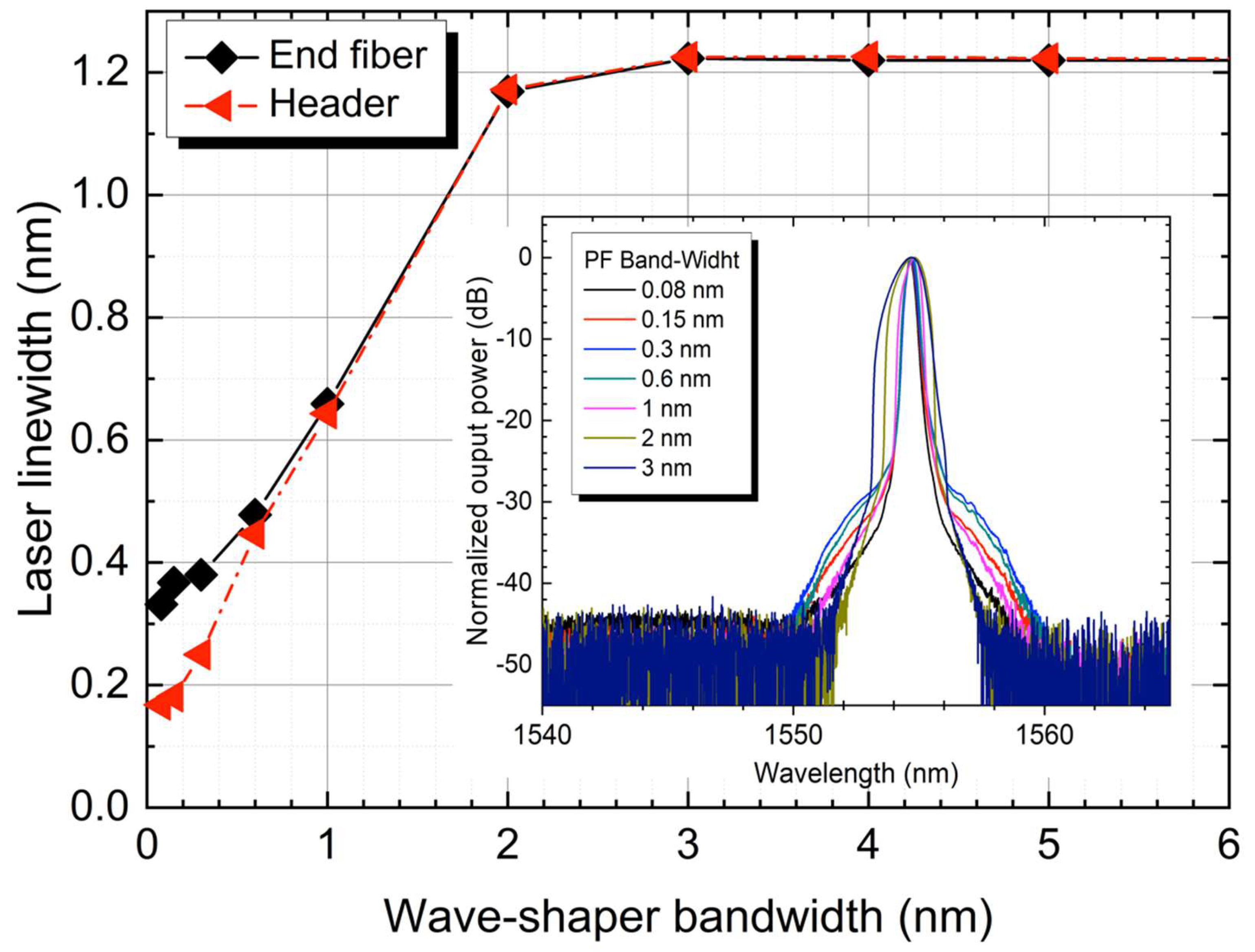Effect of Linewidth on the Relative Intensity Noise in Random Distributed Feedback Raman Fiber Lasers
Abstract
:1. Introduction
2. Materials and Methods
3. Results and Discussion
4. Conclusions
Author Contributions
Funding
Institutional Review Board Statement
Informed Consent Statement
Data Availability Statement
Conflicts of Interest
References
- Churkin, D.V.; Sugavanam, S.; Vatnik, I.D.; Wang, Z.; Podivilov, E.V.; Babin, S.A.; Rao, Y.; Turitsyn, S.K. Recent Advances in Fundamentals and Applications of Random Fiber Lasers. Adv. Opt. Photonics 2015, 7, 516–569. [Google Scholar] [CrossRef]
- Wiersma, D.S. The Physics and Applications of Random Lasers. Nat. Phys. 2008, 4, 359–367. [Google Scholar] [CrossRef]
- Turitsyn, S.K.; Babin, S.A.; El-Taher, A.E.; Harper, P.; Churkin, D.V.; Kablukov, S.I.; Ania-Castañón, J.D.; Karalekas, V.; Podivilov, E.V. Random Distributed Feedback Fibre Laser. Nat. Photonics 2010, 4, 231–235. [Google Scholar] [CrossRef]
- Rota-Rodrigo, S.; Gouhier, B.; Dixneuf, C.; Antoni-Micollier, L.; Guiraud, G.; Leandro, D.; Lopez-Amo, M.; Traynor, N.; Santarelli, G. Watt-Level Green Random Laser at 532 Nm by SHG of a Yb-Doped Fiber Laser. Opt. Lett. 2018, 43, 4284–4287. [Google Scholar] [CrossRef] [PubMed]
- Zhang, L.; Xu, Y.; Lu, P.; Mihailov, S.; Chen, L.; Bao, X. Multi-Wavelength Brillouin Random Fiber Laser via Distributed Feedback From a Random Fiber Grating. J. Light. Technol. 2018, 36, 2122–2128. [Google Scholar] [CrossRef]
- Wu, H.; Wang, Z.; He, Q.; Sun, W.; Rao, Y. Common-Cavity Ytterbium/Raman Random Distributed Feedback Fiber Laser. Laser Phys. Lett. 2017, 14, 065101. [Google Scholar] [CrossRef] [Green Version]
- Leandro, D.; Rota-Rodrigo, S.; Ardanaz, D.; Lopez-Amo, M. Narrow-Linewidth Multi-Wavelength Random Distributed Feedback Laser. J. Light. Technol. 2015, 33, 3591–3596. [Google Scholar] [CrossRef] [Green Version]
- Du, X.; Zhang, H.; Wang, X.; Zhou, P. Tunable Random Distributed Feedback Fiber Laser Operating at 1 Μm. Appl. Opt. 2015, 54, 908–911. [Google Scholar] [CrossRef] [PubMed]
- Bravo, M.; Fernandez-Vallejo, M.; Lopez-Amo, M. Internal Modulation of a Random Fiber Laser. Opt. Lett. 2013, 38, 1542–1544. [Google Scholar] [CrossRef] [PubMed] [Green Version]
- DeMiguel-Soto, V.; Leandro, D.; Lopez-Amo, M. Ultra-Long (290 Km) Remote Interrogation Sensor Network Based on a Random Distributed Feedback Fiber Laser. Opt. Express 2018, 26, 27189–27200. [Google Scholar] [CrossRef] [PubMed]
- Nuño, J.; Alcon-Camas, M.; Ania-Castañón, J.D. RIN Transfer in Random Distributed Feedback Fiber Lasers. Opt. Express 2012, 20, 27376–27381. [Google Scholar] [CrossRef] [PubMed]
- Rizzelli, G.; Iqbal, M.A.; Gallazzi, F.; Rosa, P.; Tan, M.; Ania-Castañón, J.D.; Krzczanowicz, L.; Corredera, P.; Phillips, I.; Forysiak, W.; et al. Impact of Input FBG Reflectivity and Forward Pump Power on RIN Transfer in Ultralong Raman Laser Amplifiers. Opt. Express 2016, 24, 29170–29175. [Google Scholar] [CrossRef] [PubMed] [Green Version]
- Han, B.; Rao, Y.; Wu, H.; Yao, J.; Guan, H.; Ma, R.; Wang, Z. Low-Noise High-Order Raman Fiber Laser Pumped by Random Lasing. Opt. Lett. 2020, 45, 5804–5807. [Google Scholar] [CrossRef] [PubMed]
- Ye, J.; Ma, X.; Zhang, Y.; Xu, J.; Zhang, H.; Yao, T.; Leng, J.; Zhou, P. Revealing the Dynamics of Intensity Fluctuation Transfer in a Random Raman Fiber Laser. Photonics Res. 2022, 10, 618–627. [Google Scholar] [CrossRef]
- Deheri, R.; Dash, S.; Supradeepa, V.R.; Balaswamy, V. Cascaded Raman Fiber Lasers with Ultrahigh Spectral Purity. Opt. Lett. 2022, 47, 3499–3502. [Google Scholar] [CrossRef]
- Han, B.; Dong, S.; Liu, Y.; Wang, Z. Cascaded Random Raman Fiber Laser With Low RIN and Wide Wavelength Tunability. Photonic Sens. 2022, 12, 220414. [Google Scholar] [CrossRef]
- Nuño, J.; Ania-Castañón, J.D. Anomalous RIN Transfer Function in Random Raman Lasers. In Proceedings of the 2015 European Conference on Lasers and Electro-Optics—European Quantum Electronics Conference, paper CJ_P_21, Munich, Germany, 21 June 2015. [Google Scholar]
- Rota-Rodrigo, S.; Leandro, D.; Rizzelli, G.; Ania-Castañón, J.D.; Santarelli, G.; Lopez-Amo, M. Experimental Observation of Anomalous RIN Transfer in Random Distributed Feedback Raman Fiber Lasers. In Proceedings of the 2019 Conference on Lasers and Electro-Optics Europe and European Quantum Electronics Conference, paper cj_p_78, Munich, Germany, 23 June 2019. [Google Scholar]
- Rota-Rodrigo, S.; Rizzelli, G.; Leandro, D.; Nuño, J.; Lopez-Amo, M.; Santarelli, G.; Ania-Castañón, J.D. Anomalous Relative Intensity Noise Transfer in Ultralong Random Fiber Lasers. Opt. Express 2020, 28, 28234–28242. [Google Scholar] [CrossRef] [PubMed]
- Babin, S.A.; El-Taher, A.E.; Harper, P.; Podivilov, E.V.; Turitsyn, S.K. Tunable Random Fiber Laser. Phys. Rev. A 2011, 84, 021805. [Google Scholar] [CrossRef] [Green Version]
- Babin, S.A.; Karalekas, V.; Podivilov, E.V.; Mezentsev, V.K.; Harper, P.; Ania-Castañón, J.D.; Turitsyn, S.K. Turbulent Broadening of Optical Spectra in Ultralong Raman Fiber Lasers. Phys. Rev. A 2008, 77, 033803. [Google Scholar] [CrossRef]






Publisher’s Note: MDPI stays neutral with regard to jurisdictional claims in published maps and institutional affiliations. |
© 2022 by the authors. Licensee MDPI, Basel, Switzerland. This article is an open access article distributed under the terms and conditions of the Creative Commons Attribution (CC BY) license (https://creativecommons.org/licenses/by/4.0/).
Share and Cite
Rota-Rodrigo, S.; Leandro, D.; Santarelli, G.; Lopez-Amo, M.; Ania-Castañón, J.D. Effect of Linewidth on the Relative Intensity Noise in Random Distributed Feedback Raman Fiber Lasers. Sensors 2022, 22, 8381. https://doi.org/10.3390/s22218381
Rota-Rodrigo S, Leandro D, Santarelli G, Lopez-Amo M, Ania-Castañón JD. Effect of Linewidth on the Relative Intensity Noise in Random Distributed Feedback Raman Fiber Lasers. Sensors. 2022; 22(21):8381. https://doi.org/10.3390/s22218381
Chicago/Turabian StyleRota-Rodrigo, Sergio, Daniel Leandro, Giorgio Santarelli, Manuel Lopez-Amo, and Juan Diego Ania-Castañón. 2022. "Effect of Linewidth on the Relative Intensity Noise in Random Distributed Feedback Raman Fiber Lasers" Sensors 22, no. 21: 8381. https://doi.org/10.3390/s22218381
APA StyleRota-Rodrigo, S., Leandro, D., Santarelli, G., Lopez-Amo, M., & Ania-Castañón, J. D. (2022). Effect of Linewidth on the Relative Intensity Noise in Random Distributed Feedback Raman Fiber Lasers. Sensors, 22(21), 8381. https://doi.org/10.3390/s22218381





